
back to project
(E-WASTE)


MENU || PLAYLIST

PROJECTS PLAYLIST

back to project
What happens to your electronic device or appliance?
We all love electronic gadgets Some of us even love them; we seek to have and want to get the latest electronic/electrical devices And deservedly, we are right to love them. They make our lives easier, comfortable, and entertaining and etc.
But Have you thought of what happens to that spoilt or outdated electronic/electrical gadget you dispose of some time ago. where do they final end up when they can't be use or repaired ?where do they end up.? Hold on to that thought
Let me ask you any idea what can cause a beautiful and a delight of nature, wetland into this..........
To answer the question of "what happens to your electronic device after disposal. Well, it is likely to end up among what we called E-waste.
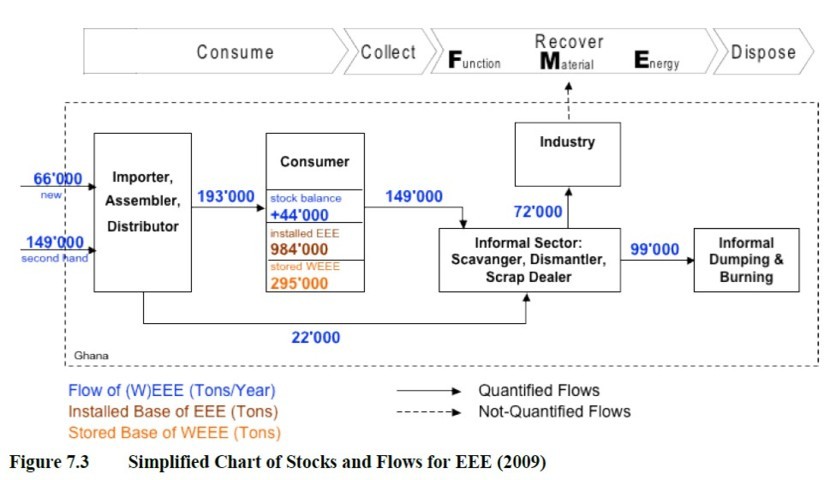
Stages every electronic gadget and appliance go through
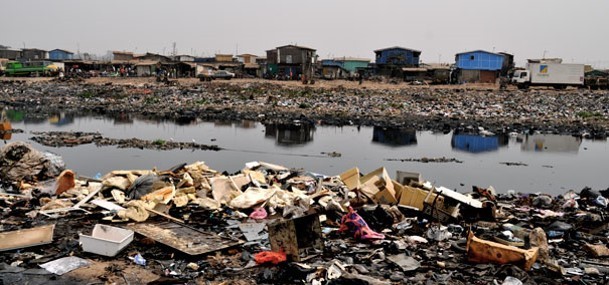
Agbogbloshie : The shame of technology
Electronic waste" may be defined as discarded computers, office electronic equipment, entertainment device electronics, mobile phones, television sets, and refrigerators.
This definition includes used electronics which are destined for reuse, resale, salvage, recycling, or disposal
- Waste Electrical and Electronic Equipment (WEEE or e-waste) represent a multi-billion dollar global industry
- Total amount of e-waste generated world-wide annually is 48.9 million metric tons
- According to a report by UNEP the amount of e-waste being produced - including mobile phones and computers - could rise by as much as 500 percent over the next decade in some countries.
- A 2011 report, "Ghana E-Waste Country Assessment", found that of 215,000 tons of electronics imported to Ghana,
- 30% were brand new and 70% were used
- Of the used product, the study concluded that 15% was not reused and was scrapped or discarded.
- The current amount of imported electronics can be estimated around to be around 400,000 tons.
- Based on previous data, the total generated E-waste which ends up at the informal sites (Agbogbloshie) is estimated around to be around 184,000 tons for the year 2014.
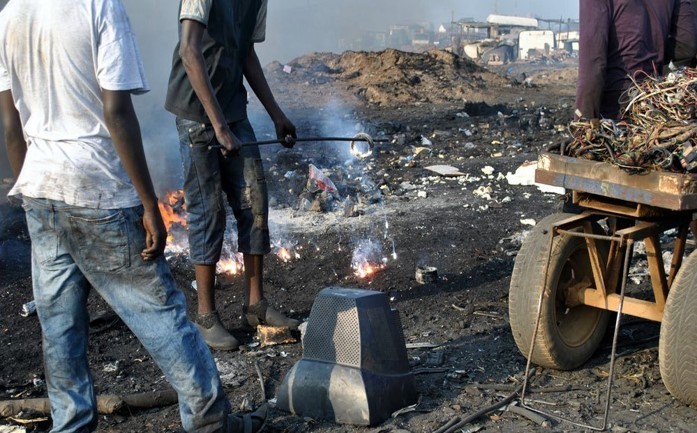
Agbogbloshie: Economic Activities breeds
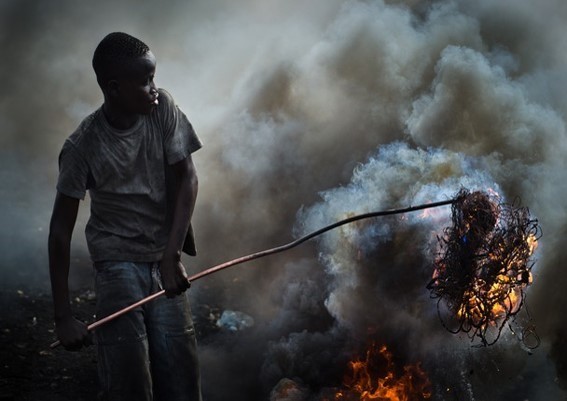
Agbogbloshie: Negative Effects of Pollution
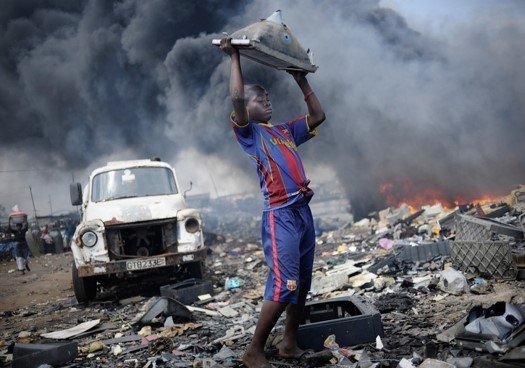
Agbogbloshie: Negative Effects of Pollution
What will it contain?
The story is told of a once named Old Fedema or Ayaalo , was a wetland, a pastoral landscape at the periphery of Accra’s urban center.
The story has it that, in 1996, 10 men migrated from the northern part of Ghana and became the first settlers of the land.
This event became the era of Agbogbloshie and this is the story as told by the scrap dealers.
The current settlement of Agbogbloshie now consists of about 6,000 families or 30,000 people, situated on the left bank of the Odaw River, and in the upper reaches of the Korle Lagoon in Accra.
There are at least four different social and economic factors driving the establishment and growth of Agbogbloshie.As at March 2014, Agbogbloshie: was the world's largest e-waste dump
- Spill-over population associated with the size and growth of the adjacent market;
- Migration from the north of Ghana, as an outcome of tribal conflict;
- Social downward movement by those forced out of more expensive areas in Accra, partly attributable to the impact of the Structural Adjustment Programme initiated in the early 1980s; and
- Cheaper settlement area free from bureaucratic constraints and high rentals in recognized formal are-as in Accra.
So what happens at the world most polluted and toxic site; Each month, cargo containers arrive in Agbogbloshie, often illegally, from countries all over the world, including the United States, the United Kingdom and Japan. The Basel Convention prevents the transfrontier shipment of hazardous waste from developed to less developed countries. Only three countries, the United States, Afghanistan and Haiti, have never ratified the convention.
Also our ever increase love for electronic goods, moreover cheap electronic stuff from this countries continuously to fuel their activities; more importation, more e-waste.
For the meantime, economic activities booms, the hustle goes on. And as a known fact, Economic Activities breeds Pollution. In this case, alarming forms of pollution. Airborne toxins from the e-waste dump continue to leach into the soil, water and food chain, both severely polluting the environment and endangering public health. Greenpeace labs tests have shown the water and soil from areas in Agbogbloshie revealed the area contained concentrations of toxins at levels a hundred times more than the allowable amount.
The Odaw River dies into a plastic waste-choked concrete canal, contributing to the harm caused by increased flooding in Accra. Exposure to these fumes is especially hazardous to children, as these toxins are known to inhibit the development of the reproductive system, the nervous system and the brain.
In similar e-waste processing areas, with conditions and demographics like those of Agbogbloshie, 80% of the children have dangerous levels of lead in their blood.
Inhabitants often suffer from chronic nausea, headaches, chest and respiratory problems.
The most alarming; Thousands of youth risk their lives every day working without safety precautions or protective gear in highly hazardous informal sector e-waste recycling.
The question which we should ask ourselves is that, “ money it worth it?”
The pollution, healthy risks and all the other negatives outcomes of this recycling activates, does it worth it
Surely, we can do something about it.

Design and Build a Copper Wire Stripper Machine
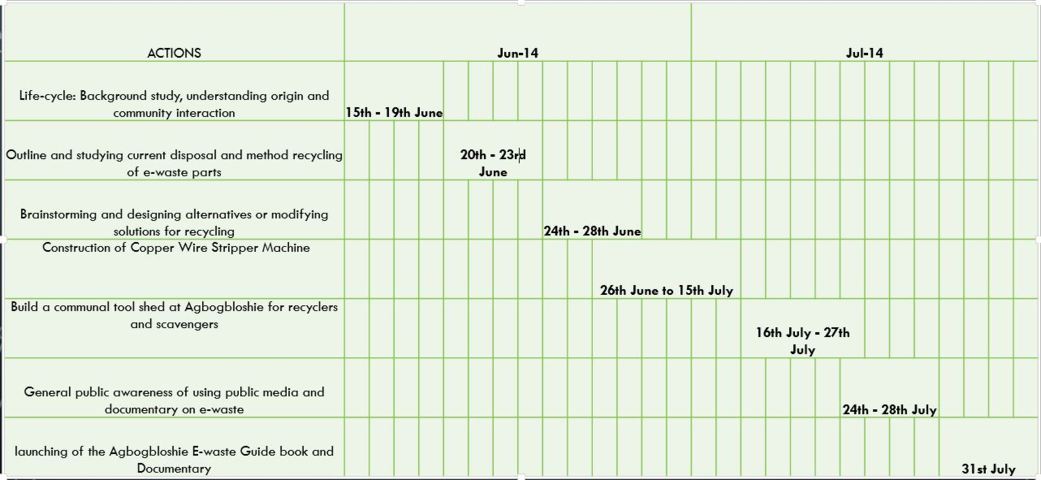
Timeline
But what can we do?
Some of the proposed solutions are;
As good as they might seems to be, implementing will not be easily something, we will all testify to.
- Forced Eviction & Demolition
- Large Scale Industrial Recycling
AMA will be our first witness to attest to this.
Force the large scale industrial recycling; it will take a strong will from the government to implement it as it require huge set-up capital.
Whiles we wait for this to help; we believe something can be done now
The E-waste Paradise team propose to use our technical backgrounds ranging from engineering to environmental science to help address the e-waste problem through several interrelated initiatives:
- Research the global cycle of e-waste from generation to imports and local recycling.
- Map the flows of e-waste by type throughout the Agbogbloshie dump site.
- Assess current methods for dismantling and disposal of e-waste at Agbogbloshie.
- Educate the local youth community about the dangers
- Design alternative approaches for improved practices of e-waste handling locally:
- Reduce e-waste generation and importation at the source.
- Re-use parts and components of e-waste.
- Recycle materials from e-waste in a sustainable manner.
- Design and Build a Copper Wire Stripper Machine
- Build a communal tool shed at Agbogbloshie for recyclers and scavengers
- Publish a guide book of how to recycle common electronic appliance and gadget with minimal engineering skills
Our Approach is to;
Engage of the local recyclers community by
- First “learning from them”, i.e. identifying their acquired expertise with respect to e-waste processing
- Co-designing and developing with them new tools and techniques for greener recycling.
Involvement & role playing of community stakeholders and concerned parties
- Scrap Dealers Association
- Agbogbloshie Makerspace Platform(AMP)
- Recyhub
- Green Advocacy Ghana
- E-waste journalist (Mike Anane) and Researchers (Rachel Field)
The selected Community is : Agbogbloshie in the greater Accra region
And the Target groups which we will be dealing with are;
- Members of the Scrap Dealers Association
- Recyclers
- E-waste scavengers
- The local makers and artesian
- Community schools ; JHS and SHS
Potential communities to also benefit ( what we will like to call Ripple effect)
- Scrap yards such as Gallaway, Kokompe and in Ashaiman
- Suame magazine
- Other makers communities
Some of the Expected Results from approach and work are; we will seek to
- Help the local community understand the complete life-cycle of e-waste but better appreciate the dangers of e-waste.
- Come up new methods and effective methods of recycling e-waste either elimination from electronic life-cycle or efficient recycling.
- Help generate more income for recyclers and scavengers through complete recycling and efficient new methods of recycling of parts of the e-waste which was previously not known to them.
- A Copper Wire Stripper will be built together with the community will help to properly recycle and eliminate the air pollution caused by burning the copper wire. This is their top most recycle activity. This will happen spread the technology, reducing pollution and generation more income for the scrap dealers and recyclers (40 to 50%) and maintaining the quality of the copper.
- Working together with the community will also enable the scrap dealers and scavengers build their own in the future.
- Communal tool shed at Agbogbloshie for recyclers and scavengers can help improve their working conditions and reduce the health risk associated with their work.
- Launch a guide book (hack book) to help amateur recyclers and the general public to recycle common household electronic gadget and devices which otherwise would have ended up as e-waste.
- Recycled electronic components will be sold (at a very cheap price) schools, universities students, electronic shops and makers community to be use in the studying of electronics and also serve as another source of income for the recyclers.
- A documentary will be shoot to help increase public awareness of e-waste pollution and its dangers to the community through flooding, health issues, environmental degradation etc
- Knowledge will help us build the more complex recycle machines.
Further funds can be sought to complete these machines in subsequent years.